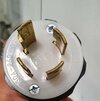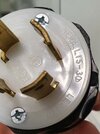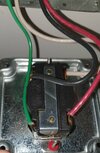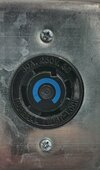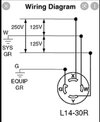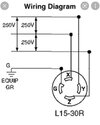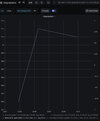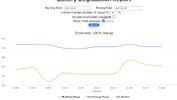Welcome to Tesla Motors Club
Discuss Tesla's Model S, Model 3, Model X, Model Y, Cybertruck, Roadster and More.
Register
Install the app
How to install the app on iOS
You can install our site as a web app on your iOS device by utilizing the Add to Home Screen feature in Safari. Please see this thread for more details on this.
Note: This feature may not be available in some browsers.
-
Want to remove ads? Register an account and login to see fewer ads, and become a Supporting Member to remove almost all ads.
You are using an out of date browser. It may not display this or other websites correctly.
You should upgrade or use an alternative browser.
You should upgrade or use an alternative browser.
MASTER THREAD: 2021 Model 3 - Charge data, battery discussion etc
- Thread starter EV Promoter
- Start date
If you think like this:I have to admit I don't know what internal resistance means. My misspent undergraduate degree brain only remember that as you approach absolute 0 materials become more conductive (ie search for a room temperature superconductor)
A battery which you measure the voltage when it is in rest will show the dormant( right expression?) voltage, voltage without any load. For example a fully charged li ion NCA like Teslas Panasonic cells will read 4.20V. Thats the definition of 100% SOC.
If you take a 100% cell and connect it to a 5 Watt lamp, the voltage vill drop a little. If you connexct a 10W lamp to the battery instead, the voltage will drop furter. The reason for the drop is the internal resistance. The higher the internal resistance, the higher the voltage drop.
Internal resistance increases at low temps and reduces at higher temps.
If you put a AA/AAA or LR6 (etc) in the fridge for a couple of hours and then take it out and try to use it in a electric toy etc, it will perform bad until the temperature comes up in the cell.
If you try to charge a battery you need to increase the voltage supplied above the cells voltage reading to get a flow of energy to the battery.
The higher the voltage, the higher the current. But the internal resistance works like a ”brake” and hinders the current.
The higher the internal resistance, the lower the current= slower charge.
As there is a maximum voltage limit for each cell supply voltage, it is the internal resistance that limits the charging power as soon as this voltage limit is reached. 4.2V/cell times 96 in series = 403V.
When 403V is reached in a SuC supply, the internal resistance set the charging speed.
(Below the 403V, its Tesla that limits the current to safe levels for the battery.)
Preheating the battery reduce the internal resistance and alloww higher current. Also, a 40C ( and plus) battery will get less wear from fast charging.
AlanSubie4Life
Efficiency Obsessed Member
YesAbout charging in the cold, why is it that the battery can take very low charging speed when cold but you can still drive and have a higher kW output? Is discharging easier on the chemistry?
(Elaborating, lithium plating is an issue when charging as I understand it (due to excessive concentration of lithium ions around the anode without proper intercalating?) but not an issue on discharge for the reverse process.)
Last edited:
As @Alansubie says, the battery probably can physically receive quite high current/power when charging in the bottom of the SOC, and Tesla probably limits the power to *not get* too much lithium plating.About charging in the cold, why is it that the battery can take very low charging speed when cold but you can still drive and have a higher kW output? Is discharging easier on the chemistry?
At higher SOC levels, the internal resistance limits the charging current/power.
To deliver power, the battery has full voltage to “overcome” the internal resistance. For example 400V divided by I ternal resistance = the resulting current.
When charging, it’s the difference between supplied voltage and the battery voltage that gives the resulting current/power.
If the battery has low SOC, the difference can be 100V giving high currents.
As the SOC raises, the battery voltage also does but the charging voltage can not be higher than 4.20V/cell(= 403V with Panaonic cells).
At 50% SOC we are at 363V or so, and the “charging force” is only about 40V so the amps/charge power goes down.
snowthewitch
Member
Can you start your tesla while it's charging? I assume you can.
Say I leave it plugged in each night, but wake up in the morning to heat up the car. Any issues?
Say I leave it plugged in each night, but wake up in the morning to heat up the car. Any issues?
You can heat the interior, including seats and steering wheel, while still plugging in. I don’t think you can drive it while plugged in but the computer, aircon etc can be usedCan you start your tesla while it's charging? I assume you can.
Say I leave it plugged in each night, but wake up in the morning to heat up the car. Any issues?
OlaM
Member
Thanks for the cold charging replies.
Picked up my Model 3 today. Haven't looked for the sticker, but the code that showed up in the registration docs was E5LD, so it's a nice new LG 82 for me! Very happy about that and happy with the whole car.
Ordered Oct 8 by the way, shipped from China Oct 21.
Picked up my Model 3 today. Haven't looked for the sticker, but the code that showed up in the registration docs was E5LD, so it's a nice new LG 82 for me! Very happy about that and happy with the whole car.
Ordered Oct 8 by the way, shipped from China Oct 21.
Do you have a way to see the nominal full pack ? I could have the 82 kWh but in total (I think usable) I have 78.7… actual now the app show me 78.5 kWhThanks for the cold charging replies.
Picked up my Model 3 today. Haven't looked for the sticker, but the code that showed up in the registration docs was E5LD, so it's a nice new LG 82 for me! Very happy about that and happy with the whole car.
Ordered Oct 8 by the way, shipped from China Oct 21.
OlaM
Member
Do you have a way to see the nominal full pack ? I could have the 82 kWh but in total (I think usable) I have 78.7… actual now the app show me 78.5 kWh
Soon, I have an OBD2 reader coming in the mail. 82 is never net 82 usable is it? High 70s is good for the "82" as far as I understand it.
Hi all,
Not sure if this is the right place to ask this question but I looked around and could not find a better one.
We have a L15-30 250V 30A 3phase outlet available at work and was wondering if I can charge off of it. The photos show the available plug and receptacle used at work.
I've found this adapter plug(see link below) which suggests I can but wanted to check if anyone out there is using such setup.
L15-30 to 14-50 Adapter plug
Your help would be greatly appreciated.
Not sure if this is the right place to ask this question but I looked around and could not find a better one.
We have a L15-30 250V 30A 3phase outlet available at work and was wondering if I can charge off of it. The photos show the available plug and receptacle used at work.
I've found this adapter plug(see link below) which suggests I can but wanted to check if anyone out there is using such setup.
L15-30 to 14-50 Adapter plug
Your help would be greatly appreciated.
Attachments
theothertom
Member
I do that every morning using the Tesla app on my phone. Doesn't matter if the car is plugged in or not.Say I leave it plugged in each night, but wake up in the morning to heat up the car. Any issues?
theothertom
Member
I don't think EVSEs (aka chargers) in the US are set up for 3 phase. I think they use 3 phase chargers in Europe, though. Maybe someone else knows better than me.We have a L15-30 250V 30A 3phase outlet available at work
That is true - can't charge off all 3-phases in the USA because the USA plug only has 2 poles.I don't think EVSEs (aka chargers) in the US are set up for 3 phase. I think they use 3 phase chargers in Europe, though. Maybe someone else knows better than me.
But, if you have charged on a L2 charger that reads ~208V, you have charged on 2 of 3 phases of a 3 phase power supply. Most USA commercial buildings are powered with 3 phase 208V power where there is 120V between each hot wire and neutral, and 208V between each hot wire.
So if you have a 4-plug 3-phase 208V plug, you just need an adapter that taps two of the hot wires and you can just ignore the 3rd hot wire.
In the pics above, I'm a bit concerned that I see a white wire on a L15-30 receptacle. White should only be used for neutral lines unless otherwise marked. Typically a 3-phase wire would use black, red and blue for the hot wires. If it is indeed a hot wire, it should be marked with electrical tape, usually black or red.
Paige111
Member
They should be required to give the customer CoC in USA, its ridiculous how they can get away w/putting any size battery in the 3 & not tell the customer, they say it’s proprietary info, they cant tell the customer. My only request was for the 82KWH battery, per my VIN decoding Im suppose to have the BT42 (82KWH). Im sure Tesla would tell me my battery size if it was 82KWH, but they always just give me inconsistent, inaccurate responses ( one T support said it was a 65kwh CATL) If I had known it wasnt a 82KWH battery, I wouldnt of bought the car.How do you get your CoC? Can I request it before paying?
It will be interesting to see what your rated range displays once you collect the car. I received mine (UK) on the 11th December and it has never displayed the rated range. I think the most it ever did was 340 miles.
How do you get your CoC? Can I request it before paying?
Thanks for the detailed info!That is true - can't charge off all 3-phases in the USA because the USA plug only has 2 poles.
But, if you have charged on a L2 charger that reads ~208V, you have charged on 2 of 3 phases of a 3 phase power supply. Most USA commercial buildings are powered with 3 phase 208V power where there is 120V between each hot wire and neutral, and 208V between each hot wire.
So if you have a 4-plug 3-phase 208V plug, you just need an adapter that taps two of the hot wires and you can just ignore the 3rd hot wire.
In the pics above, I'm a bit concerned that I see a white wire on a L15-30 receptacle. White should only be used for neutral lines unless otherwise marked. Typically a 3-phase wire would use black, red and blue for the hot wires. If it is indeed a hot wire, it should be marked with electrical tape, usually black or red.
I measured the outlet some time ago and if I remember correctly it showed 120V. Now I wonder if this perticular one is 14-30.
I'll check again on Monday and report back.
Attachments
That is exactly what happened to me. I considered canceling as a silent protest against the system but what’s the point ? So, either get the car I didn’t want (75 kWh) or keep driving the Volvo. I bought the TeslaThey should be required to give the customer CoC in USA, its ridiculous how they can get away w/putting any size battery in the 3 & not tell the customer, they say it’s proprietary info, they cant tell the customer. My only request was for the 82KWH battery, per my VIN decoding Im suppose to have the BT42 (82KWH). Im sure Tesla would tell me my battery size if it was 82KWH, but they always just give me inconsistent, inaccurate responses ( one T support said it was a 65kwh CATL) If I had known it wasnt a 82KWH battery, I wouldnt of bought the car.
I see that my teslafi range( in the battery degradation report) varies quite much despite that the Nominal Full Pack is steady at the same level. Do we know why the teslafi range varies like this?
Also, at a quite long time during the autumn I had a NFP of 80.3-80.4 kWh and the max range in Scan My Tesla was mostly about 503-504km. The teslafi range was about the same. Now the NFP is above 81kWh, the SMT max range is 507-509km but the teslafi shows a lower range(about 500-502km). I have tried to find the reson for the lower range, it doesnt seem to be the temperature as I can have days with the same NFP but the temperature and the range doesnt show any consistence in the changes.
Also, at a quite long time during the autumn I had a NFP of 80.3-80.4 kWh and the max range in Scan My Tesla was mostly about 503-504km. The teslafi range was about the same. Now the NFP is above 81kWh, the SMT max range is 507-509km but the teslafi shows a lower range(about 500-502km). I have tried to find the reson for the lower range, it doesnt seem to be the temperature as I can have days with the same NFP but the temperature and the range doesnt show any consistence in the changes.
Attachments
SMT reads the NFP directly, while Teslafi has to calculate the battery capacity from the rated miles reading and percent SOC that it gets from the API. The percent SOC from the API is only given as a whole number, so there will be more variation in the Teslafi value due to the rounding error.I see that my teslafi range( in the battery degradation report) varies quite much despite that the Nominal Full Pack is steady at the same level. Do we know why the teslafi range varies like this?
Also, at a quite long time during the autumn I had a NFP of 80.3-80.4 kWh and the max range in Scan My Tesla was mostly about 503-504km. The teslafi range was about the same. Now the NFP is above 81kWh, the SMT max range is 507-509km but the teslafi shows a lower range(about 500-502km). I have tried to find the reson for the lower range, it doesnt seem to be the temperature as I can have days with the same NFP but the temperature and the range doesnt show any consistence in the changes.
The max range in SMT is also an estimate, because the SMT rated miles is only read as a whole number.
Thank you, very good info!SMT reads the NFP directly, while Teslafi has to calculate the battery capacity from the rated miles reading and percent SOC that it gets from the API. The percent SOC from the API is only given as a whole number, so there will be more variation in the Teslafi value due to the rounding error.
The max range in SMT is also an estimate, because the SMT rated miles is only read as a whole number.
Similar threads
- Replies
- 22
- Views
- 9K
- Replies
- 73
- Views
- 13K
- Replies
- 4
- Views
- 12K
- Article
- Replies
- 27
- Views
- 17K
- Replies
- 52
- Views
- 33K



